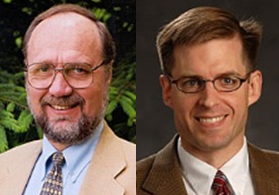Craig Van Gelder (at right in the lighter jacket) serves as tenured professor of congregational mission at Luther Seminary in St. Paul, MN, having taken this position in 1998 following ten years as professor of domestic missiology at Calvin Theological Seminary in Grand Rapids, MI. He holds two earned Doctor of Philosophy degrees: Mission (Southwestern Baptist Theological Seminary) and Administration in Urban Affairs (University of Texas at Arlington). Van Gelder was ordained by the Presbyterian Church (U.S.A.) in 1984 and the Christian Reformed Church in 1990. He is the author of The Essence of the Church: A Community Created by the Spirit (2000); editor of Confident Witness-Changing World: Rediscovering the Gospel in North America (1999); a contributing author of Missional Church: A Vision for the Sending of the Church in North America (1988); and co-author, with Dwight J. Zscheile The Missional Church in Perspective: Mapping Trends and Shaping the Conversation (2011).
Dwight J. Zscheile (at right in the darker jacket) completed his Doctor of Philosophy degree at Luther Seminary with a focus on congregational mission and leadership in 2008. Since that time, he has served that institution as an assistant professor of congregational mission and leadership. Zscheile, an ordained Episcopal priest. has served as executive pastor at St. David’s Episcopal Church, Ashburn, VA, and currently serves part-time as associate priest at St. Matthew’s Episcopal Church in St. Paul, MN. The Missional Church in Perspective: Mapping Trends and Shaping the Conversation, co-authored with Craig Van Gelder, is his first book.
Book Basics
The Missional Church in Perspective is the first and only book that explores the development of the term missional by noting the broad historical and theological contributing factors and thoroughly exploring the recent literature. It is a must read for anyone who uses the term or regularly reads authors who do so. While the co-authors work as a team throughout the text, Van Gelder takes the lead for the first part (chapters 1-3) allowing Zscheile to do so for the latter part (chapters 4-6).
“Part 1: The History and Development of the Missional Conversation” serves as the book’s greatest contribution to the understanding of the term mission. Van Gelder is uniquely qualified to explore the varied usage of the term, since it was popularized as the result of a book he contributed to: Missional Church: A Vision for the Sending of the Church in North America (1988). In addition to exploring and critiquing the 1998 text, Van Gelder charts the recent literature as a part of a missional tree. In that illustration, the 1998 book serves as the trunk; church and missions/mission Trinitarian missiology, missio Dei, reign (kingdom) of God, church’s missionary nature, and missional hermeneutics serve as the roots; and the recent literature are grouped by theme to serve as the branches: discovering, utilizing, engaging, and extending. Each branch and its associated subbranches are explored in relation to the “biblical and theological themes” that inform them and in relation to recent literature that is representative of it (p.69).
“Part 2: Perspectives That Extend the Missional Conversation” seeks to apply the wealth of information in the first part to the contemporary church through chapters focusing on theological frameworks, engaging culture, and church life and leadership. While Zscheile offers numerous helpful insights that enable readers to understand how the missional church should be embodied, this section does not significantly extend the missional conversation by introducing new or controversial possibilities. Instead, it offers data points to encourage readers to think more about concepts and, ideally, to engage others in that conversation with the intent to act upon those discoveries.
So What?
In the introduction, Van Gelder and Zscheile suggest the recent missional church literature includes four common themes:
- God is a missionary God who sends the church into the world.
- God’s mission in the world is related to the reign (kingdom) of God.
- The missional church is an incarnational (versus an attractional) ministry sent to engage a postmodern, post-Christendom, globalized context.
- The internal life of the missional church focuses on every believer living as a disciple engaging in mission (p. 3-4).
- How would you define the term “missional church?”
- Were you aware that the term did not find its way into popular usage until relatively recently?
- What is your initial reaction to the four common themes in the latest literature?
Craig Van Gelder and Dwight J. Zscheile. The Missional Church in Perspective: Mapping Trends and Shaping the Conversation (Baker Academic, 2011). ISBN: 9780801039133.
